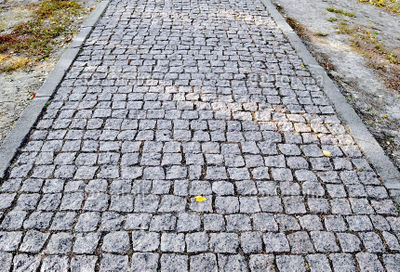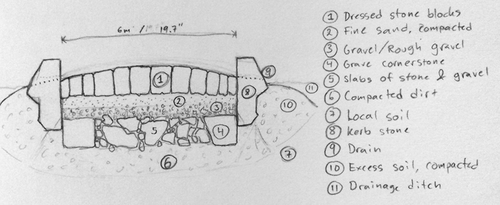Coins
The Coins is the name of thousands of miles of established trade routes initiated by Harald the Builder some hundreds of years ago, originally under the name of he Great Road. The road system was so named from the money it was meant to provide and the money it does provide. The entire stretch of official Coins road is cobbled in some manner, most in a specific manner to keep the roads working as long as possible. It is the safest way to travel in the Realms, since it is patrolled by the elite soldiers of the Stripes.
History
Harald the Builder realised that one of the difficulties during the orevious wars had been logistics and felt that in his time of peace the newfound Empire needed to keep control of the lands by rapid transportation of supplies. The main argument proposed to the people was trade, however, and "Brotherhood in Peace". During its initiation, noble houses were not allowed to use the Great Road for military purposes other than ones sanctioned by the Empire, as dictated in the Law of the Great Road. This was later relaxed to allow movement of troops between own cities. But pecause of this ruleset and the eventual collapse of the Empire, the roads really have mainly been used for trade. It's such a big cooperation with such great profits that very few infractions have been made to this rule, and those who have broken it have been fined hefty sums, sometimes collapsing the entire Kingdom after conquering some particular land or area.
The road building started between Capitoleum and the nearby cities and after finishing those, a much more grand building scheme was started, where the majority of today's stretches of road were built in one fell swoop. This means that though the roads vary locally depending on the local materials, the roads are fairly uniform and more modern additions have been made in the same fasion.
Since the initiation of the roads, the Stripes have been patrolling them. Originally just Capitoleum citizens, but it was changed over time to include trained soldiers of all Road Houses.
In many cases the roads were built nearby the older road tracks, since traders and transports still needed to move through the lands. Especially since when the older roads were excavated or simply built upon, these riders had to go around the construction area and caused a lot of havoc. Today most old roads are grown over by either crops or low-level vegetation, but some are in use by locals, especially if they were located some distance away from the newly built road which aimed to be more straight than its predecessors.
Road Design
The planned road area is first excavated a bit larger than the road width of 6m and the bottom soil is then compacted thoroughly (6). Then large solid corner stones that usually are flat at least outwards are placed at the bottom of the excavation (4) and other large slabs are placed in between (5). Outside of these are placed large kerb stones that are shaped to strengthen the road (8) and has slots for drainage (9). The stones are supported by a small wall of dirt on each side made from the excavated dirt (10) and creates a natural place for rain water to drain off of the road (11). Sometimes a ditch is specifically dug on each side of the road.
The slabs in the bottom of the road construction is then covered in a layer of gravel (3) and again covered with sand (2) that is compacted. Finally the road adds surface cobbles (1) that are made with a slight curve, making rain water drain away to the sides and the draining slots in the kerb stones.
As far as possible, the builders try to use local materials both for building the road and maintenance.
Traveling the Coins
Milestones are placed near the road every 5km or so and toll houses ("Coinhouses") are build roughly every 60km. Waystations are also placed along the way (sometimes in conjunction with a tollhouse) to house the Stripes, Coins Crews as well as road equipment and materials. These have no such precise definition of where they are as they take into account old and new province borders, local weather, or level of road crimes.
An unintended side effect of the protection and quality of the Coins (though Coins roads are not the only cobbled roads) that people use other roads less if, they can. The other side effect is that crime is slightly higher on other roads, again increasing the demand for Coins roads. With traffic coming in both directions and sometimes quite high kerb stones means queues actually can occur in the middle of nowhere as it can be hard to overtake other travellers on wagons.
Protection
It is highly unlikely to encounter highwaymen on the Coins, though it naturally can happen. Frequent patrols by the Stripes either as a pair or a "fist" (5 men) on horseback both enforce the Law of the Coins. The Stripes also acts as scouts, both directly and indirectly; at least one of the Stripes soldiers will be packing lighter and wear less armour so that he can quickly run away to report any larger infractions; if a patrol doesn't arrive within a given timeframe to the next waystation, a larger contingent of Stripes are sent out together with a couple of messenger pigeons and at least one runner.
Waystations
The waystations are located roughly a little bit less than a day's travel from one another, 30km or so, and are more frequent in areas where there is a higher chance of crime. Of course, this has changed over the years, so some waystations have been leased out to locals where they have often been converted to inns. These are, however, leased with a contract that enables the Stripes to end the lease before the end of term, in case they require the facilities again. Because of this, there are in reality waystation buildings at least every 20 km or so.
Because of the varying nature of waystations, the fact that they generally are manned by someone and that they work as small fortifications, small villages can build up around them, with shops, houses and other services. The rule is that no other building, erection or vehicle can be placed within a 15 m radius from the waystation. When leased, this is rarely followed.
Local provinces are in charge of providing rations and equipment to waystations and need to guarantee that certain items always will be available; in return, these items are bought at a cost slightly higher than market price when needed.
Waystations are normally staffed with between 15-25 Stripes men and 3-5 household staff to clean, wash and cook and there are guest bunks for Coins Crews.
Patrols
Stripes patrols are generally at least 4 per day in both directions between two waystations. The first patrol is around dawn and then their timings and patrol size vary in a randomly determined way, to make sure it can not be taken advantage of. As mentioned, there are always at least 2 soldiers on patrol and at least 1 on "scout duty" with lighter gear and a fast horse. A common number of soldiers is 5, but this can be more or less.
Of course, if a Stripes soldier can be bribed, this can be circumvented, but it's a fairly good life as a Stripes soldier, so the amount needed to bribe a bribeable solider is fairly high.
If a patrol comes across an ambush, they are to just run, but if they come across a less thought through highwayman, they are entitled to kill him or imprison him. The latter option will sentence the would-be bandit to several years of forced labour and give the patrol a small bonus.
Maintenance
Maintenance is primarily taken care of by a number of Coins Crews (sometimes nicknamed 'Coinscrews' or 'Screws', but in less base vernacular: 'Crews') that share the waystations with the Stripes. There is a big difference in quality of beddings etc for the Coins Crews, however, and they know their status is well below that of the Stripes. The task of the Coins Crew is masonry-related and they really just repair road damage. Any clearing on the sides of the roads from bushes and other low vegetation is required by local provinces to deal with as part of Road House costs, covered by Coins taxation gains.
Because the roads very rarely break or need repairs, the crews are often travelling thousands of miles in a year and are away from their homes for months at a stretch. Though very few serious damages need to be fixed, there are not very many crews available, so there is always a long queue of things to fix around the vast network of roads.
Tollhouses and economy
Tollhouses, or 'Coinhouses', are used as a means to pay for the upkeep of the roads and its protection and doesn't generally give any profit to the Road Houses. Never the less, the upkeep is a noticeable cost and the Stripes requires significant amounts of resources. Most of the time, Road Houses still have to pay some amount of money to pay towards the road's costs, as the toll costs are determined centrally by the Road Houses and not by local provinces.
The Tollhouses themselves are placed roughly every one and a half day's of travel apart (60 km or so) and often built in conjunction with province borders and with a Waystation, making them a part of the wall between provinces (if they a stone wall exists as a border). Each tollhouse is located next to a gate that is handled by a Tollmaster and a Toll handler who live with their families in a combined house.
Since it's hard to find staff that is willing to work basically all hours and to charge even friends a toll, the houses are relatively luxurious compared to for other housing for similarly ranked non-gentry people, including a small plot of land and the salary is fairly good, enabling the family to save. There is sometimes some contention between Waystation staff and Tollhouse staff.
For Tollhouses without an accompanying Waystation, it is less likely to sprout a local village; the Tollhouse is essentially self-sufficient and the Tollmaster/Toll handler are only allowed to leave the Tollhouse on specific occasions (and one of them must remain), making them bad customers for traders.
The biggest total cost of managing a stretch of the Coins is to pay the patrolling cost of the Stripes and this cost is almost never covered by road tolls. Unlike the other main roads of a kingdom where local lords accomodate maintenance and security, the Coins is patrolled by non-local soldiers with (presumably) less inclination to take bribes and more motivated to deal with criminals harshly.
- Stripes patrolling - biggest cost
New Roads
- Some are newer.
- If a Road House can't or won't pay, they reroute it.
- Sometimes reroute anyway for political reasons.
- Several old roads still very useable even hundreds of years later.

